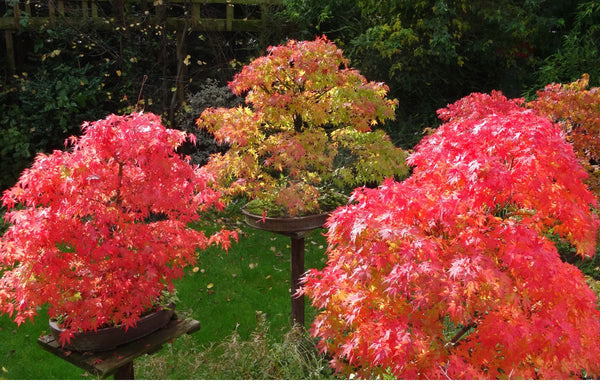
The Elegance of Japanese Maples
Japanese Maples, or Acer palmatum, have been a treasured part of Japanese horticulture for centuries, celebrated for their seasonal colour change known as "Momiji." These trees, with their iconic finger-like leaves, have become widely admired ornamental plants, gracing gardens around the world, where their elegance brings a refined touch to outdoor spaces.

The Introduction of Japanese Maples to the UK
Introduced to the UK through plant trade and exploration in the 19th and 20th centuries, Japanese Maples have grown in popularity thanks to their unique beauty and relatively low maintenance. With proper care, these trees can thrive in the varied climate of the UK, making them a favourite among gardeners who want to add a touch of Japan to their landscapes.

Growing Japanese Maples in Pots
Despite being full-sized trees, Japanese Maples are slow-growing, making them ideal for container planting or bonsai cultivation. Their slow growth and resilience make them particularly suited to the UK’s gardening conditions, whether for urban courtyards or larger outdoor spaces.
When choosing a pot, opt for one that is wider rather than deep, as these trees have shallow root systems. A pot about 60cm in diameter or with a volume of 50-75 litres is usually a good fit. Ensure that the pot has proper drainage to prevent waterlogging, which can harm these delicate trees.
For young trees, use a snug pot, just slightly larger than the root ball, to avoid pot shock that can happen when there’s too much space for the roots to spread out. Looking for more inspiration? Explore our selection of stylish and functional outdoor garden pots to upgrade your space.
Care Tips for Potted Japanese Maples
-
Sunlight and Placement: In the UK, Japanese Maples prefer partial shade or dappled sunlight. Place your tree in a sheltered position, away from the harsh afternoon sun and strong winds, which can damage its delicate foliage.
-
Temperature: Japanese Maples thrive in cooler climates, making them well-suited to the UK’s temperate weather. They prefer a temperature range of 13-24°C but can tolerate frost with the right protection. During heatwaves, provide extra shade and hydration, especially in southern regions.
-
Soil: These trees perform best in well-draining, slightly acidic to neutral soil. A loose, aerated soil mix will encourage strong root growth. Adding mulch around the base helps retain moisture and stabilise soil temperature, essential for healthy growth in the UK climate.
-
Watering: Keep the soil consistently moist but avoid over-watering. Water deeply when the top 5-10cm of soil feels dry. During hotter months, especially in shallow pots, the soil may dry out quicker, so regular checks are important.
-
Fertilisation: The ideal time to fertilise your Japanese Maple is in late winter or early spring as it starts its growing season. Use a balanced, slow-release fertiliser with low nitrogen to encourage healthy, steady growth rather than rapid, weak development.
-
Pruning: Prune regularly to maintain the tree’s shape and health. Remove dead or damaged branches and thin out dense areas to allow light and air to reach the inner parts of the tree. Many UK gardeners favour a domed canopy style for their Japanese Maples.
-
Repotting: As your tree grows, it will need repotting every 2-3 years, ideally during its dormant period in late autumn or winter. This reduces stress on the tree. If you wish to keep the tree in the same pot, root pruning will be necessary to prevent it from becoming root-bound.

Common Problems and Solutions for Potted Japanese Maples
-
Drying Out: In warmer parts of the UK or during dry periods, potted Japanese Maples can dry out quickly. Consider using a self-watering pot or installing a drip irrigation system to help maintain moisture levels, especially in containers.
-
Root-Bound: As the tree grows, its roots may outgrow the pot, leading to root-bound conditions. Signs include stunted growth, wilting, or a reduction in leaf production. Repotting or root trimming is essential to prevent this.
-
Pests and Diseases: Japanese Maples can occasionally fall victim to common pests such as aphids or fungal issues like powdery mildew. Regularly inspect your tree and treat infestations with organic insecticides or fungicides as necessary.
-
Fertilisation Issues: Avoid over-fertilising, particularly with nitrogen-heavy products, as they encourage rapid, weak growth. Japanese Maples prefer slow, steady development. Avoid feeding the tree in late summer or autumn to prevent frost-sensitive new growth.
-
Wind Damage: Japanese Maples have expansive canopies, making them susceptible to wind damage, especially when grown in pots. Wide pots provide better stability, but placing your tree in a wind-sheltered area is important to prevent tipping or broken branches.
Japanese Maples are a stunning addition to any UK garden, offering an ever-changing display of beauty throughout the year. Whether grown in the ground or in pots, these trees bring a sense of peace and timelessness to outdoor spaces.
Japanese maples bring sophistication to any garden. To complement their beauty, consider pairing them with Luxury Garden Pots for UK Outdoor Spaces. For a tropical twist, explore ideas in 8 Plants to Turn Your Garden Into a Tropical Paradise.
If you’re looking for bold additions, learn about The Golden Barrel Cactus: A Striking Addition to Your Garden. Learn how to care for a Magnolia Tree here.
